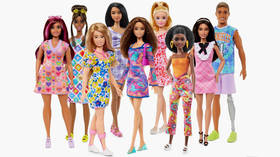Down’s syndrome Barbie doll makes debut


US toy manufacturing giant Mattel has released a Barbie bearing features associated with Down’s syndrome in a move it says will help make its range of dolls more diverse and help all children to find a toy with which they can identify.
The doll, which is available to purchase online from Tuesday, will “enable all children to see themselves in Barbie,” Mattel says. It is designed with features associated with Down’s syndrome, such as a shorter frame and a longer torso. It also has a rounder face with smaller ears to represent women who have the genetic condition.
The design comes as part of the brand’s ‘Barbie Fashionistas’ line, which also includes a Barbie with a prosthetic leg, another that comes in a wheelchair, and a range of male dolls that are thinner and less muscular than previous iterations.
Mattel says the line is its “most diverse and inclusive doll line, offering a variety of skin tones, eye colors, hair colors and textures, body types, disabilities and fashions, to inspire even more stories.”
Barbie doll with Down’s syndrome launched by MattelMattel bosses said they wanted to bring out the doll to “enable all children to see themselves in #Barbie”. They partnered with the National Down Syndrome Society US to bring the product to market. https://t.co/Zf5YzAKvs6pic.twitter.com/V62ORmCTQ3
— Marsha Collier (@MarshaCollier) April 25, 2023
It comes after previous efforts by Mattel to develop its dolls beyond the traditional blonde-hair-blue-eyes and thin-waisted style with which Barbies are traditionally associated. An academic study conducted by the University of South Australia in 2009 found that just one in 100,000 women likely had the body type of a traditional Barbie doll.
In recent years, Mattel has also released a doll wearing a hijab as a tribute to Ibtihaj Muhammad, the first American athlete to compete at the Olympic Games while wearing the headdress.
Kandi Pickard, president and chief executive of the National Down Syndrome Society (NDSS), with whom Mattel consulted on the line, said the range “means so much for our community, who for the first time can play with a Barbie doll that looks like them.” She added: “It is a huge step forward for inclusion.”
Mattel’s production of the doll comes after similar moves by other toy manufacturers. In 2016, Lego released a minifigure of a young man in a wheelchair as part of its ‘Toys Like Me’ drive. Previously, it had come under fire for only representing elderly models of people in wheelchairs.